In This Page:-
Naked Eye Observations
Below are the details of the world record crescent observations, which were seen by naked eye, we will list three records, which are: youngest age, minimum lag time and smallest elongation from Sun.
Youngest Age:-
- Observer Name: John Pierce
- Month Name: Shaban 1410 AH.
- Location: Collins Gap, Tennessee, USA.
- Longitude: 83.5 W
- Latitude: 35.6 N
- Elevation: 1500 m
- Topocentric Conjunction: 25 February 1990 CE, at 08:54 UT.
- Geocentric Conjunction: 25 February 1990 CE, at 08:22 UT.
- First Visibility: 25 February 1990, at 23:55 UT.
- Topocentric Age (At First Visibility): 15 hours and 01 minute.
- Geocentric Age (At First Visibility): 15 hours and 33 minutes.
- Lag time: 39 minutes
- Elongation (at Best Time): 7.6 degrees.
- Relative Azimuth (at Best Time): 0.6 degree.
- Relative Altitude (at Best Time): 7.6 degrees.
- Source of Observation: Prof. Bradley Schaefer Papers.
Minimum Lag Time:-
- Observer Name: N/A
- Month Name: Rabeea' Awwal 1411 AH.
- Location: Ashdod, Palestine.
- Longitude: 34.7 E
- Latitude: 31.8 N
- Elevation: 60 m
- Topocentric Conjunction: 18 September 1990 CE, at 23:37 UT
- Geocentric Conjunction: 19 September 1990 CE, at 00:46 UT
- First Visibility: 20 September 1990 CE.
- Topocentric Age (At Best Time): 40 hours and 18 minutes.
- Geocentric Age (At Best Time): 39 hours and 09 minutes.
- Lag time: 29 minutes
- Elongation (at Best Time): 19.4 degrees.
- Relative Azimuth (at Best Time): 18.4 degree.
- Relative Altitude (at Best Time): 5.9 degrees.
- Source of Observation: SAAO Papers.
Smallest Elongation from Sun:-
- Observer Name: John Pierce
- Month Name: Shaban 1410 AH.
- Location: Tennessee, USA.
- Longitude: 83.5 W
- Latitude: 35.6 N
- Elevation: 1500 m
- Topocentric Conjunction: 25 February 1990 CE, at 08:54 UT.
- Geocentric Conjunction: 25 February 1990 CE, at 08:22 UT.
- First Visibility: 25 February 1990, at 23:55 UT.
- Topocentric Age (At First Visibility): 15 hours and 33 minutes.
- Geocentric Age (At First Visibility): 15 hours and 01 minute.
- Lag time: 39 minutes
- Elongation (at First Visibility): 7.7 degrees.
- Relative Azimuth (at Best Time): 0.6 degree.
- Relative Altitude (at Best Time): 7.6 degrees.
- Source of Observation: Prof. Bradley Schaefer Papers.
Optical Aid Observations
Below are the details of the world record crescent observations, which were seen using optical aid, we will list four records, which are: youngest topocentric age, youngest geocentric age, minimum lag time and smallest elongation from Sun.
Youngest Topocentric Age:-
- Observer Name: Jim Stamm
- Month Name: Jumadal Awwal 1433 AH Waxing Crescent.
- Equipment: 8" Telescope.
- Location: Tucson, Arizona, USA.
- Longitude: 110.9808 W
- Latitude: 32.4322 N
- Elevation: 876 m
- Topocentric Conjunction: 22 March 2012 CE, at 13:31 UT.
- Geocentric Conjunction: 22 March 2012 CE, at 14:37 UT.
- Last Visibility: 23 March 2012 CE, at 01:54 UT.
- Topocentric Age (At Last Visibility): 12 hours and 23 minutes.
- Geocentric Age (At Last Visibility): 11 hours and 17 minute.
- Lag time: 24 minutes
- Elongation (at Last Visibility): 6.0 degrees.
- Relative Azimuth (at Last Visibility): 3.4 degree.
- Relative Altitude (at Last Visibility): 5.0 degrees.
- Source of Observation: ICOP.
Youngest Geocentric Age:-
- Observer Name: Jim Stamm
- Month Name: Jumadal Awwal 1433 AH Waxing Crescent.
- Equipment: 8" Telescope.
- Location: Tucson, Arizona, USA.
- Longitude: 110.9808 W
- Latitude: 32.4322 N
- Elevation: 876 m
- Topocentric Conjunction: 22 March 2012 CE, at 13:31 UT.
- Geocentric Conjunction: 22 March 2012 CE, at 14:37 UT.
- Last Visibility: 23 March 2012 CE, at 01:54 UT.
- Topocentric Age (At Last Visibility): 12 hours and 23 minutes.
- Geocentric Age (At Last Visibility): 11 hours and 17 minute.
- Lag time: 24 minutes
- Elongation (at Last Visibility): 6.0 degrees.
- Relative Azimuth (at Last Visibility): 3.4 degree.
- Relative Altitude (at Last Visibility): 5.0 degrees.
- Source of Observation: ICOP.
Minimum Lag Time:-
- Observer Name: Abbas Ahmadian.
- Month Name: Ramadan 1428 AH.
- Equipment: 14" Telescope.
- Location: Esfahan, Iran.
- Longitude: 52.23 E
- Latitude: 32.45 N
- Elevation: 3350 m
- Topocentric Conjunction: 11 September 2007 CE, at 13:50 UT
- Geocentric Conjunction: 11 September 2007 CE, at 12:44 UT
- First Visibility: 12 September 2007 CE, at 14:49 UT
- Topocentric Age (At Best Time): 25 hours and 11 minutes.
- Geocentric Age (At Best Time): 26 hours and 16 minutes.
- Lag time: 20 minutes
- Elongation (at Best Time): 12.1 degrees.
- Relative Azimuth (at Best Time): 11.4 degree.
- Relative Altitude (at Best Time): 4.1 degrees.
- Source of Observation: ICOP.
Smallest Elongation from Sun:-
- Observer Name: Jim Stamm
- Month Name: Jumadal Awwal 1433 AH Waxing Crescent.
- Equipment: 8" Telescope.
- Location: Tucson, Arizona, USA.
- Longitude: 110.9808 W
- Latitude: 32.4322 N
- Elevation: 876 m
- Topocentric Conjunction: 22 March 2012 CE, at 13:31 UT.
- Geocentric Conjunction: 22 March 2012 CE, at 14:37 UT.
- Last Visibility: 23 March 2012 CE, at 01:54 UT.
- Topocentric Age (At Last Visibility): 12 hours and 23 minutes.
- Geocentric Age (At Last Visibility): 11 hours and 17 minute.
- Lag time: 24 minutes
- Elongation (at Last Visibility): 6.0 degrees.
- Relative Azimuth (at Last Visibility): 3.4 degree.
- Relative Altitude (at Last Visibility): 5.0 degrees.
- Source of Observation: ICOP.
Daylight Observations
Below are the details of young crescents which were observed at daylight time using optical aid, and the observer was not able to see the crescent after sunset despite having clear sky after sunset.
Shawwal 1428 AH:-
- Observer Name: Jim Stamm
- Month Name: Shawwal 1428 AH.
- Equipment: 8" Telescope.
- Location: Tucson, Arizona, USA.
- Longitude: 110.9645 W
- Latitude: 32.4204 N
- Elevation: 842 m
- Topocentric Conjunction: 11 October 2007 CE, at 05:23 UT.
- Geocentric Conjunction: 11 October 2007 CE, at 05:01 UT.
- First Visibility: 11 October 2007 CE, at 21:40 UT (14:40 LT).
- Topocentric Age (At First Visibility): 16 hours and 17 minutes.
- Geocentric Age (At First Visibility): 16 hours and 39 minutes.
- Lag time: 05 minutes
- Elongation (At First Visibility): 8.8 degrees.
- Relative Azimuth (at First Visibility): 10.2 degree.
- Relative Altitude (at First Visibility): 2.7 degrees.
- Moon Altitude (at First Visibility): 34.1 degrees.
- Sun Altitude (at First Visibility): 36.8 degrees.
- Note: The observer was not able to see the crescent even through the telescope after sunset! It was only seen at daylight time.
- Source of Observation: ICOP.
Camera Imaging
Below are the details and photos of crescents captured by a camera connected to a telescope. Some of these pictures were taken at daylight
Youngest Geocentric Age:-
- Observer Name: Thierry Legault.
- Month Name: Jumadal A'ula 1431 AH.
- Location: Montfaucon, France.
- Longitude: 1 34'30"E
- Latitude: 44 41'52"N
- Elevation: 300m.
- Telescope: Takahashi FSQ-106ED with focal reducer (D=106mm, F=400mm) on Losmandy Titan German equatorial mount.
- Camera Model: Lumenera Skynyx L2-2 monochrome video camera (1616x1212 pixels of 4.4 microns).
- Filter: Low-pass infrared filter 850nm in luminance.
- Number of Frames: 500 frames (pictures).
- Shooting Date: 14 April 2010 CE.
- Shooting Time: 14:29 (UT+2).
- Topocentric Conjunction: 14 April 2010 CE, at 13:22 UT.
- Geocentric Conjunction: 14 April 2010 CE, at 12:29 UT.
- Photo Time: 14 April 2010 CE, at 12:29 UT.
- Topocentric Age (At Photo Time): Minus 00 hours and 53 minutes.
- Geocentric Age (At Photo Time): ZERO Hours ZERO minutes!!
- Topocentric Elongation (At Photo Time): 4.554 degrees.
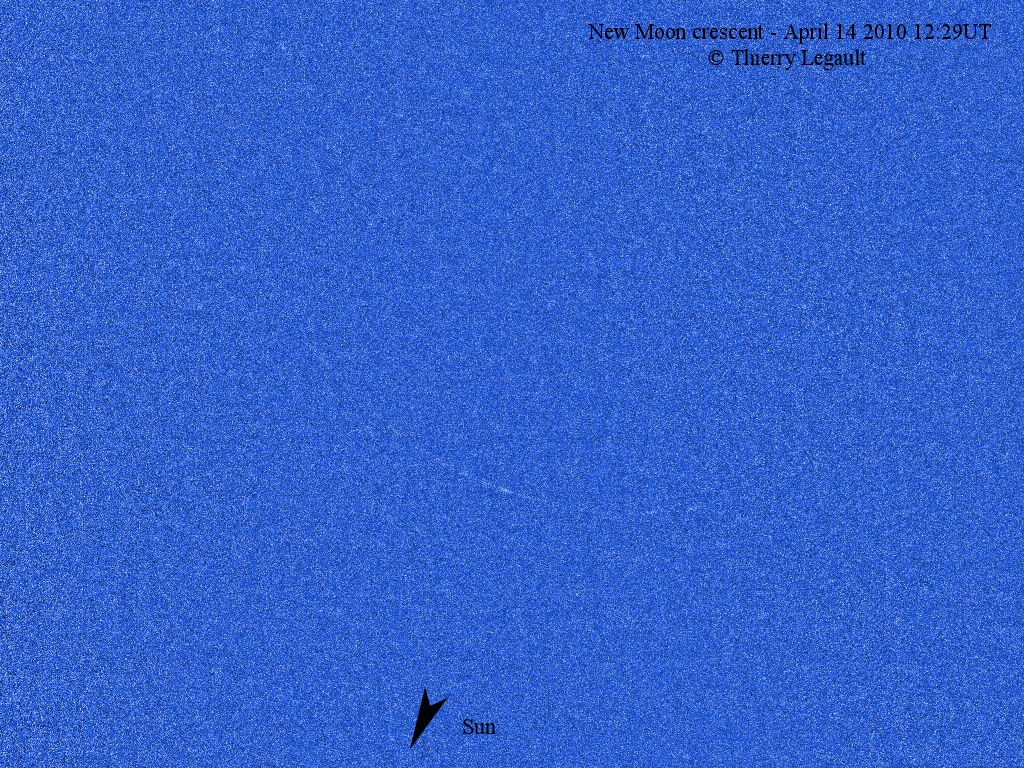
Kindly Click on the Image to Enlarge
Youngest Topocentric Age:-
- Observer Name: Martin Elsasser.
- Month Name: Jumadal A'ula 1429 AH.
- Location: Munich, Germany.
- Longitude: 11 36'25"E
- Latitude: 48 07'18"N
- Elevation: 550m.
- Telescope: Williams FLT110, at 770mm focal length, with MAM50 mount.
- Camera Model: DMK41AF02.AS
- Filter: Visual/ir filters in the telescope, transmission starts at 680nm.
- Number of Frames: Unknown [About 300 frames (pictures)].
- Shooting Date: 05 May 2008 CE.
- Shooting Time: 15:03 (UT+2).
- Topocentric Conjunction: 05 May 2008 CE, at 13:07 UT.
- Geocentric Conjunction: 05 May 2008 CE, at 12:18 UT.
- Photo Time: 05 May 2008 CE, at 13:03 UT.
- Topocentric Age (At Photo Time): Minus ZERO hours and 04 minutes.
- Geocentric Age (At Photo Time): ZERO Hours and 45 minutes.
- Topocentric Elongation (At Photo Time): 4.585 degrees.
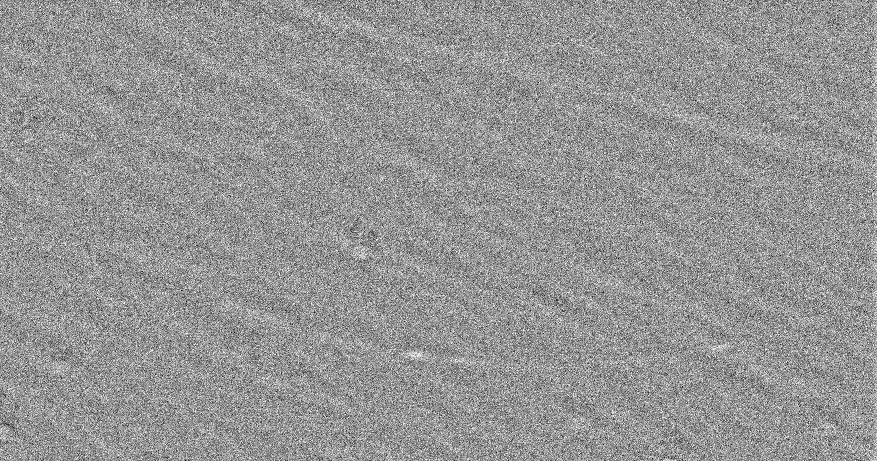
Kindly Click on the Image to Enlarge
Smallest Elongation from Sun:-
- Observer Name: Vincent Jaques.
- Month Name: Muharram 1433 AH.
- Location: Breil-sur-Roya, France.
- Longitude: 7 30'E
- Latitude: 43 56'N
- Elevation: 500m.
- Telescope: L80/600 ED / eq6 Goto mount.
- Camera Model: DMK 21
- Filter: 950nm filter + red 0.5.
- Number of Frames: N/A.
- Shooting Date: 25 November 2011 CE.
- Shooting Time: 11:49 (UT+1).
- Topocentric Conjunction: 25 November 2011 CE, at 04:44 UT.
- Geocentric Conjunction: 25 November 2011 CE, at 06:10 UT.
- Photo Time: 25 November 2011 CE, at 10:49 UT.
- Topocentric Age (At Photo Time): 06 hours and 05 minutes.
- Geocentric Age (At Photo Time): 04 hours and 39 minutes.
- Topocentric Elongation (At Photo Time): 3.42 degrees.
- Website Report and Photos: Click Here
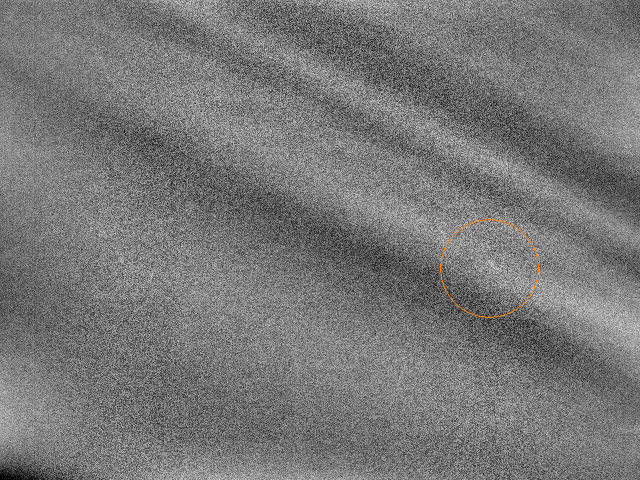
Kindly Click on the Image to Enlarge
World Record in Muslim World:
- Observer Name: Mohammad Odeh.
- Month Name: Waning Rajab 1446 AH.
- Location: Al-Khatim Observatory, Al-Khatim area, UAE.
- Longitude: 54:55 E
- Latitude: 24:13 N
- Elevation: 87m.
- Telescope: Explore Scientific 102mm APO Refractor Telescope, 714mm FL.
- Camera Model: ZWO ASI174MM.
- Filter: 685 nm Filter.
- Number of Frames: 190 to 500 Frames.
- Shooting Date: 29 January 2025 CE.
- Shooting Time: 15:52 (UT+4).
- Topocentric Conjunction: 29 January 2025 CE, at 14:23 UT.
- Geocentric Conjunction: 29 January 2025 CE, at 12:36 UT.
- Photo Time: 29 January 2025 CE, at 11:52 UT.
- Topocentric Age (At Photo Time): Minus 02 hours and 31 minute.
- Geocentric Age (At Photo Time): Minus 00 hours and 44 minutes.
- Topocentric Elongation (At Photo Time): 4.4 degrees.
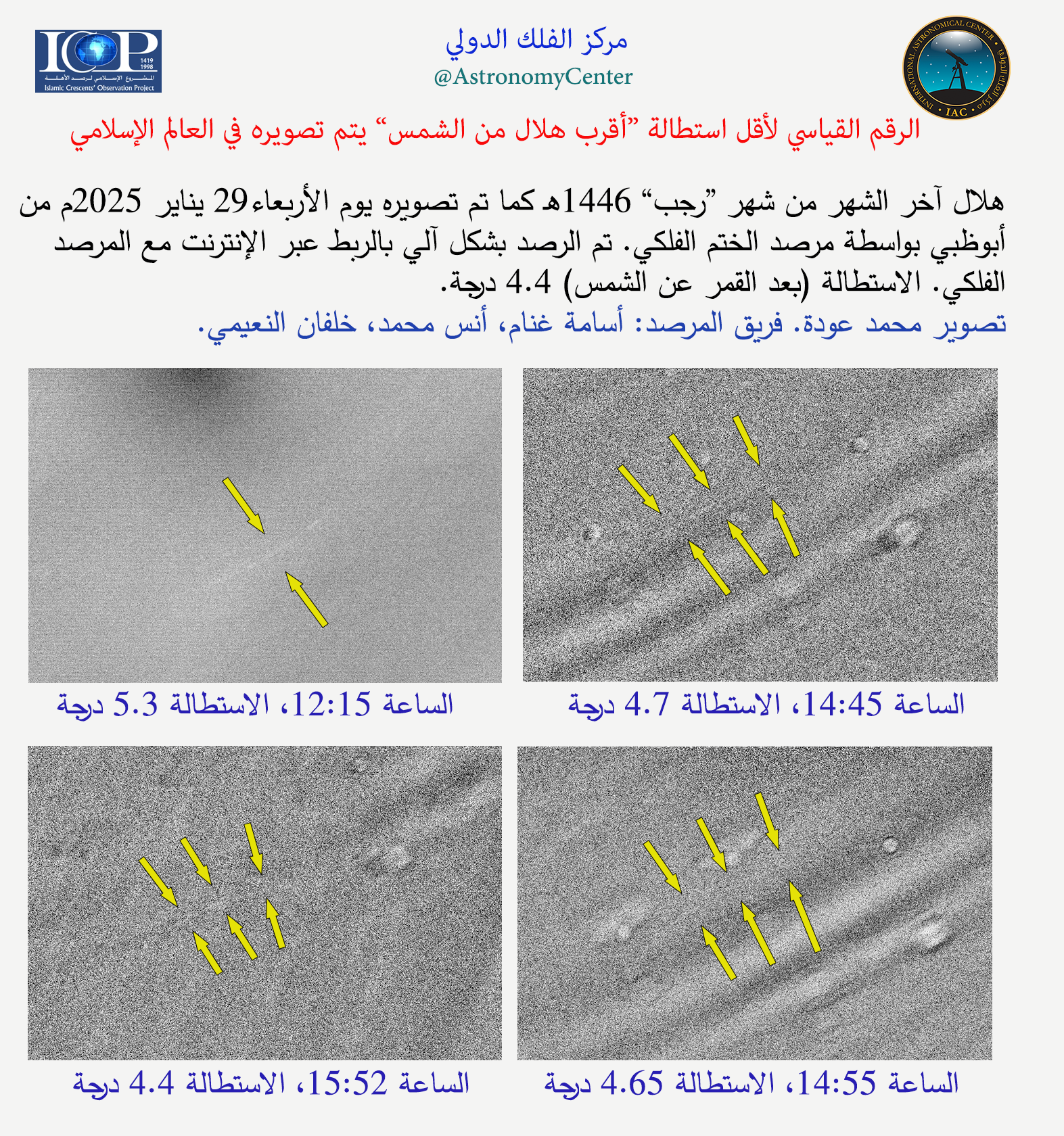
Kindly Click on the Image to Enlarge.
Definitions
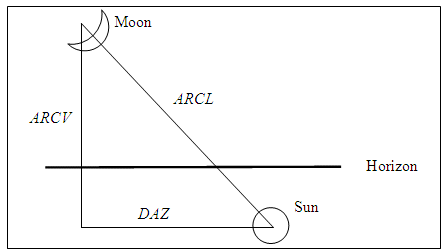
Note from ICOP Memeber Mr. Qamar Uddin: "Please could you also make a special mention of the fact that those "World Records Crescent Observations" are carried out by astronomy experts, who have a lot of experience of knowing when and where to look (possibly with optical aids to find the moon)! So, that ordinary Muslims may not "blame" themselves for not seeing the crescent at the same time/location."
By Mohammad Odeh. Copyright © 1998-2019. IAC, All Rights Reserved. This material may not be reproduced in any form without permission. For more information Kindly send E-mail





